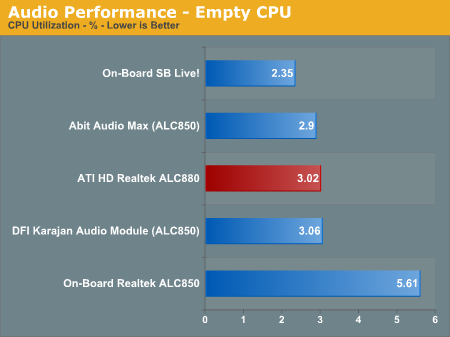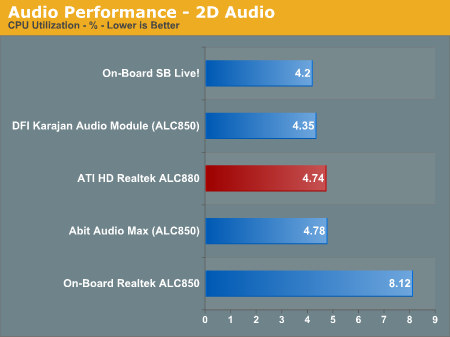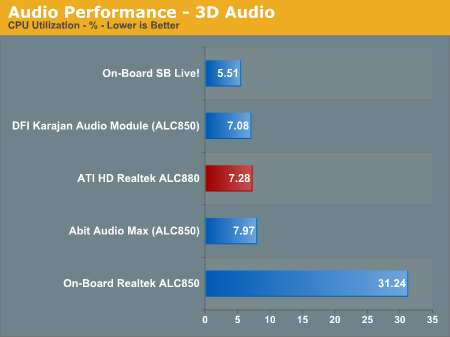Sapphire PURE Innovation - ATI's Chipset for the AMD Enthusiast
by Wesley Fink on July 29, 2005 12:05 AM EST- Posted in
- Motherboards
Audio Performance
For audio testing, we used Rightmark 3D Sound CPU utilization test, which is the same benchmark run in our earlier nForce4 SLI and Ultra roundups. This benchmark measures the overhead or CPU utilization required by a codec or hardware audio chip.



It is very important to point out that the ATI Crossfire AMD is the first Athlon 64 board to deliver Azalia High Definition audio. Those who have been complaining about the poor AC'97 audio present on most AMD boards should be very pleased to find Azalia HD on the ATI.
We did some subjective listening tests with the ATI Azalia HD through a Dolby amplifier and a 5.1 speaker setup. The ATI Azalia HD was in a completely different league from the other audio solutions that we have tested on Athlon 64. Noise was virtually nonexistent, and the imaging and depth were superb when listening to Orff's Carmina Burana. The same CD sounded thin, noisy, and artificial through a more common ALC850 fed to the same Dolby amp and 5.1 speakers. This is not to say that the Azalia HD is at the same level as the very best audio cards, but it is a lot closer than what we think many of you imagine.
As the first implementation of Azalia HD audio on A64, the HD Realtek ALC880 features:
- High-performance DACs with 100dB S/N ratio
- ADCs with S/N ratio greater than 85dB
- Meets performance requirements for audio on PC2001 systems
- 8 DAC channels support 16/20/24-bit PCM format for 7.1 audio solution
- 3 stereo ADCs support 16/20-bit PCM format, two for microphone array, one for legacy mixer recording
- Supports 44.1K/48K/96K/192kHz DAC sample rate
- All ADCs support 44.1K/48K/96K sample rate
- Applicable for 4-channel/192kHz and 6-channel/96kHz DVD-Audio solutions
- Up to four channels of microphone input are supported for AEC/BF application
- High-quality differential CD input
- Supports Power Off CD function
- Supports external PCBEEP input and built-in BEEP generator
- PCBEEP Pass-Through when link is in RESET state
- Software selectable 2.5V/3.75V VREFOUT
- Six VREFOUTs are supported by default, with additional four VREFOUTs available by sharing unused analog I/O pins
- Two GPI (General Purpose Input) jack detection pins (each designed to detect 4 jacks)
- 16/20/24-bit S/PDIF-OUT supports 44.1K/48K/96kHz sample rate
- 16/20/24-bit S/PDIF-IN supports 44.1K/48K/96kHz sample rate
- Optional EAPD (External Amplifier Power Down) supported
- Power support: Digital: 3.3V; Analog: 3.3V/5.0V
- Power management and enhanced power saving features
- Compatible with AC'97
- 48-pin LQFP package (lead-free package also available)
- Reserve analog mixer architecture for backward compatibility with AC'97
- -64dB ~ +30dB with 1dB resolution of mixer gain to achieve finer volume control
- Impedance sensing capability for each re-tasking jack
- All analog jacks are stereo input and output re-tasking for analog plug & play
- Built-in headphone amplifier for each re-tasking jack
- Supports external volume knob control
- Supports 2 GPIOs (General Purpose Input/Output) for customized applications
- Hardware de-scrambling for DVD-Audio Content protection
- Meets Microsoft WHQL/WLP 2.0 audio requirements
- EAXTM 1.0 & 2.0 compatible
- Direct Sound 3DTM compatible
- A3DTM compatible
- I3DL2 compatible
- HRTF 3D Positional Audio
- Emulation of 26 sound environments to enhance gaming experience
- 10 Software Equalizer Bands
- Voice Cancellation and Key Shifting in Karaoke mode
- Realtek Media Player
- Enhanced Configuration Panel and device sensing wizard to improve user experience
- Microphone Acoustic Echo Cancellation (AEC) and Beam Forming (BF) technology for voice application
- Mono/Stereo Microphone noise suppression
- ALC880D features Dolby® Digital Live output for consumer equipment










52 Comments
View All Comments
QueBert - Saturday, July 30, 2005 - link
I like the white, but not a big fan of red. As for it being the "first white motherboard we've seen" There was a really sweet looking one by I believe, Epox. Platinum colored PCB with blue and gold on the board. The color scheme of this Sapphire is different, and different is good. I hate green/red PCB's.beorntheold - Saturday, July 30, 2005 - link
Under Gaming Performance:"... If you keep in mind that the orange bar represents the same NVIDIA 6800 Ultra used to test the other boards in this review, you can clearly see that the Sapphire ATI is at or near the top in most game tests..."
There is either an error in the graph or in the text - because the orange bar clearly says
nV 7800 GTX.
Olaf van der Spek - Saturday, July 30, 2005 - link
> This number is meaningless as far as hard disk performance is concerned as it is just the number of IO operations completed in a second.What exactly is meant here?
Isn't more completed operations per second better?
Wesley Fink - Saturday, July 30, 2005 - link
I meant that the operations per second is meaningless as a SPECIFICATION of hard drive performance. Yes, more operations per second is better, but you will never see iPeak ops/sec quoted as a specification.roel - Saturday, July 30, 2005 - link
And what about support for linux?Will it boot? Will it be fast as well?
I'd like to know.
roel
kevykev - Friday, July 29, 2005 - link
What is with the stupid fish names though? How ridiculous.TheInvincibleMustard - Saturday, July 30, 2005 - link
Actually, that was one of the first things to catch my eye ... Not the fish, but the jaguar, with the silkscreened logo looking almost exactly the same as the automobile company (Google Images if you're curious). The actual leaping cat is positioned slightly differently between the two, but the similarity is remarkable.If I had better image manipulation on this machine I'm at, I'd whip up a side-by-side comparison to better illustrate (hehe) my point.
shoRunner - Friday, July 29, 2005 - link
All i can say is drool, this definately looks like a very promising board, if they can fix the issue with the USB transfer rates(even without a fix its will still be very competative, how often do most ppl transfer huge amounts of data over USB?). What i still want to see is one of these boards with the integrate graphics and a DVI port.Stas - Friday, July 29, 2005 - link
Just as I expected: nVidia is whooped. ATi + AMD = PerformanceZebo - Friday, July 29, 2005 - link
Looks great Wes..cept for memory is to close together and not staggard and may present cooling problems between the sticks...plus the board looks like green snot, much prefer blacks, reds and blues.